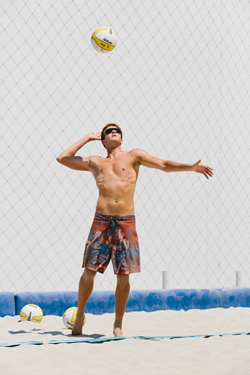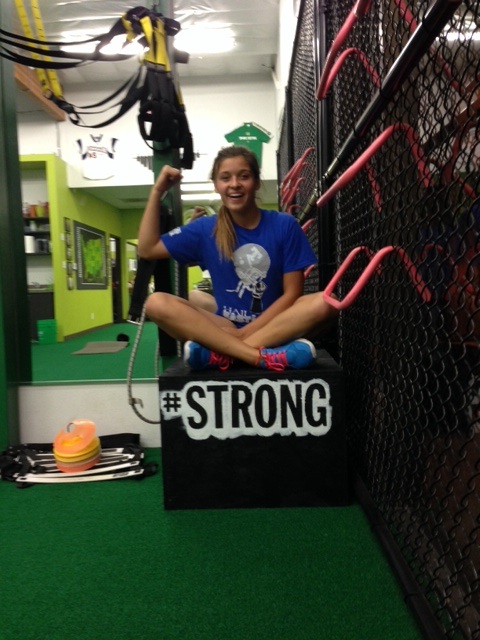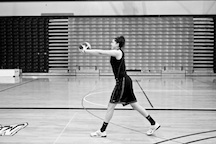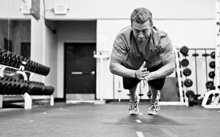Increasing upper body power comes down to 3 things: overall strength, power production, and movement speed.

The research on increasing upper body power can be a little bit confusing. First of all, most research out there is done on recreational athletes (ages 18-22) or elite athletes of about the same age. There are few studies on the age we are talking about (9-17 years), but there's just enough that we can get a clear understanding of what works both scientifically and practically. If we stick to some basic principles that hold true for all ages then we can figure out how to effectively increase power.
Let me quickly clarify what we mean by power so we can get to the good stuff. We want our junior high/high school volleyball players hitting so hard they can give someone a concussion (yes this has happened). We want our baseball/softballers hitting bombs and throwing out runners at home from anywhere on the field. We want our tennis players serving aces consistently. We want our basketball players to throw chest passes with such precision and power that there's no way someone's going to pick off their pass. We have seen our athletes transform and be able to do these things because there are some simple principles that we stick to. Let's check it out...

1.) Overall strength:
There is just no denying the fact that you HAVE to build a solid strength foundation to increase power. Research shows that athletes with stronger upper bodies swing harder, throw harder, and hit the ball harder. Building a foundation of strength comes in different ways depending on how advanced an athlete is and their age. For example, we can build strength in a 8 year-old athlete by doing a body weight bear crawl or inch worm or pushup. We can use those same simple exercises with some of our 14 year-olds who are incredibly weak. Our advanced athletes will still do these exercises, but it becomes a warm-up instead of the workout.
You can only increase strength so far without using external resistance (like dumbbells). In order to increase muscle mass, you must overload your musculature system, and your body quickly adapts to using just your bodyweight. We are building absolute strength. We talked about this in a previous article on Training with Underweight and Overweight balls, and covered the principle that we must build absolute strength and absolute speed (which we will talk about next). A friend who coaches college basketball made the mistake of asking me "a workout is just a workout, right?". My response, "A basketball practice, is just a basketball practice, right?". All workout's are NOT the same. Let's take a look at a practical example: throwing a ball or hitting a volleyball.
-You need strength in the stabilizing muscles (the smaller muscles): the rotator cuff in order to control the movement of the humeral head. The rotator cuff compresses the head of the humerous into the glenoid fossa to create stability during the throwing/hitting motion.
-Then you need strength in the prime movers (the bigger muscles): the deltoid, latissimus, and pec major
-Then your shoulder must be loose enough (proper mobility) to get the range of motion necessary to throw a baseball or hit a volleyball.
That's the simplified version of what goes on when considering what we put into a workout to increase upper body power. To increase power, we need to build strength in the rotator cuff (smaller muscles) and the prime movers (bigger muscles). And then we need to increase power production. In broad terms, Yes - we do pressing exercises, we do pulling, we do some accessory work (bicep curls, tricep extensions...) and we do stabilizing excerices.

2.) Power production:
Research has shown that the process of increasing upper body power is slightly different then increasing lower body power. In advanced athletes, (athletes who have been lifting for 1 year +) performing a heavy lift before an explosive exercise can effectively increase lower body power (ex. heavy squat, followed by maximal vertical jump). Research has not shown this to be true in upper body exercises though. For example, some research has shown that doing hypertrophy training (3 sets of 10 bench press) before doing a power exercise (bench press throw) can actually have acute negative effects on power. The research only shows acute negative effects on power, meaning were not sure what it does in the long run. What we do know is that powerful upper body exercises alone can increase upper body power.
For example, research done comparing a chest press vs. plyometric pushup program has shown that plyometric pushups were more effective at increasing upper body power. I'm not saying that upper body plyo's are better then strength exercises, but research has shown plyo's to be effective at increasing power production.
I have all of my athletes (girls and guys) do some type of plyo pushup (among other upper body plyo's). Most of my girls do clap pushups on their knees right now (or a combo of regular and knee clap pushups). Here's one of our 12 year old's doing clap (plyo) pushups:
https://www.youtube.com/watch?v=h1dFzRYS6yU

3.) Movement speed
Movement speed goes hand-in-hand with power production, but we will make it it's own category to make it a little easier. Everyone has to know some string-bean of an athlete who hits the snot out of the ball. You know who I am talking about - those lanky athletes who have very little fat or muscle, but somehow throw 90+ mph, hit bombs, and spike straight down. How is this possible? Movement speed.
Take a peek at this video of an athlete for Torrey Pines who hits incredibly hard... and she is pretty twiggy.
https://www.youtube.com/watch?v=-T7XGf0k6hg
How do we train movement speed? Well, we don't do 30 lb Medicine ball throws. When looking to increase movement speed, we do very light MB work. Very light meaning 4-6 lb tosses for our bigger athletes. Heavy MB tosses aren't a bad thing, but you can not generate the speed you need to see improvements in movement speed when using heavier loads.
Check out this video of one of our 13 year old volleyball players doing an overhead MB wall slam. She's using a 6lb MB, and we may even want to go a little lighter because you can see her speed is pretty good, but not great.
https://www.youtube.com/watch?v=w9yVyLMM3Pk
The Program:
Let's look at a sample program a 6'1'' high school freshman female volleyball player. Things that stick out right away - lanky, not much upper body strength, can't do 1 real pushup, poor shoulder mobility, coach says she hits a "soft" ball. Where do we go from there? We address the shoulder mobility with some exercises like a side-lying windmill, then we build strength with things like 1-arm chest press, and inverted row (this is the advanced version), and then address some shoulder stability with external rotation and wall slides. We add in some power exercises like MB overhead slams and clap pushups and we have a very basic upper body program. That's the simplified version of what we do. We focus on 3 key things - increasing strength, power production, and movement speed - and we see athletes crush balls over the fence, hit straight down, and throw bullets. Pretty cool job if you ask me.
References:
Effect of Heavy Dynamic Resistive Exercise on Acute Upper-Body Power (2001)
Comparison of Dynamic Push-up training and plyometric Push-up training on Upper-Body Power and Strength (2000)
Complex training in Professional Rugby Players: Influence of Recovery time on Upper-body power output (2009)
Adaptations in Upper-body maximal strength and Power output resulting from Long-Term Resistance Training in Experienced Strength-Power Athletes (2006)
Acute Negative Effect of a Hypertrophy-Oriented Training Bout on Subsequent Upper-body Power output (2003)
Upper Body Strength and Power Characteristics in female Fastpitch Athletes (abstract)
Relationship between Upper-Body Strength and Bat Swing Speed in High-school Baseball Players (2012)

